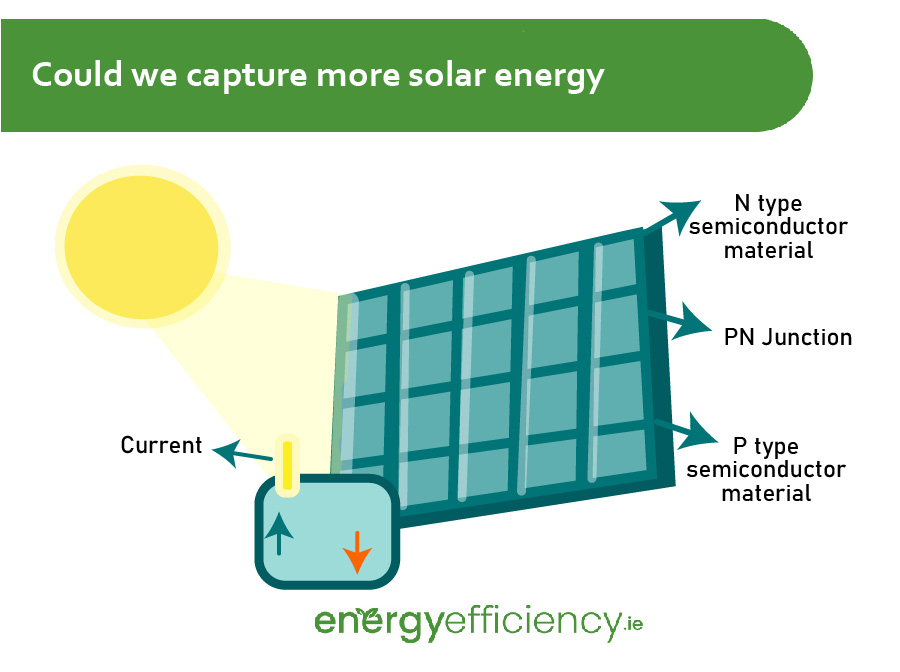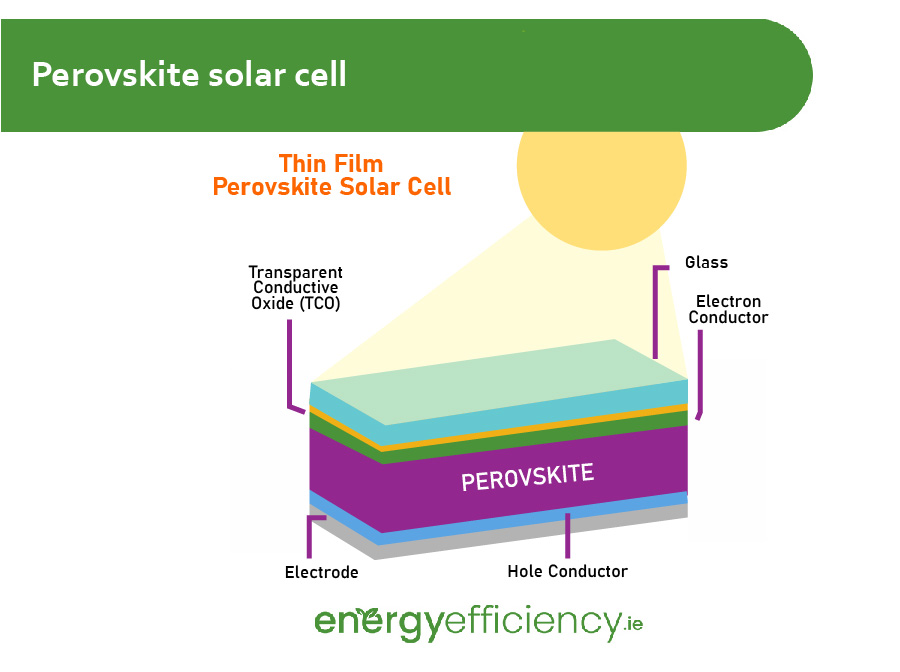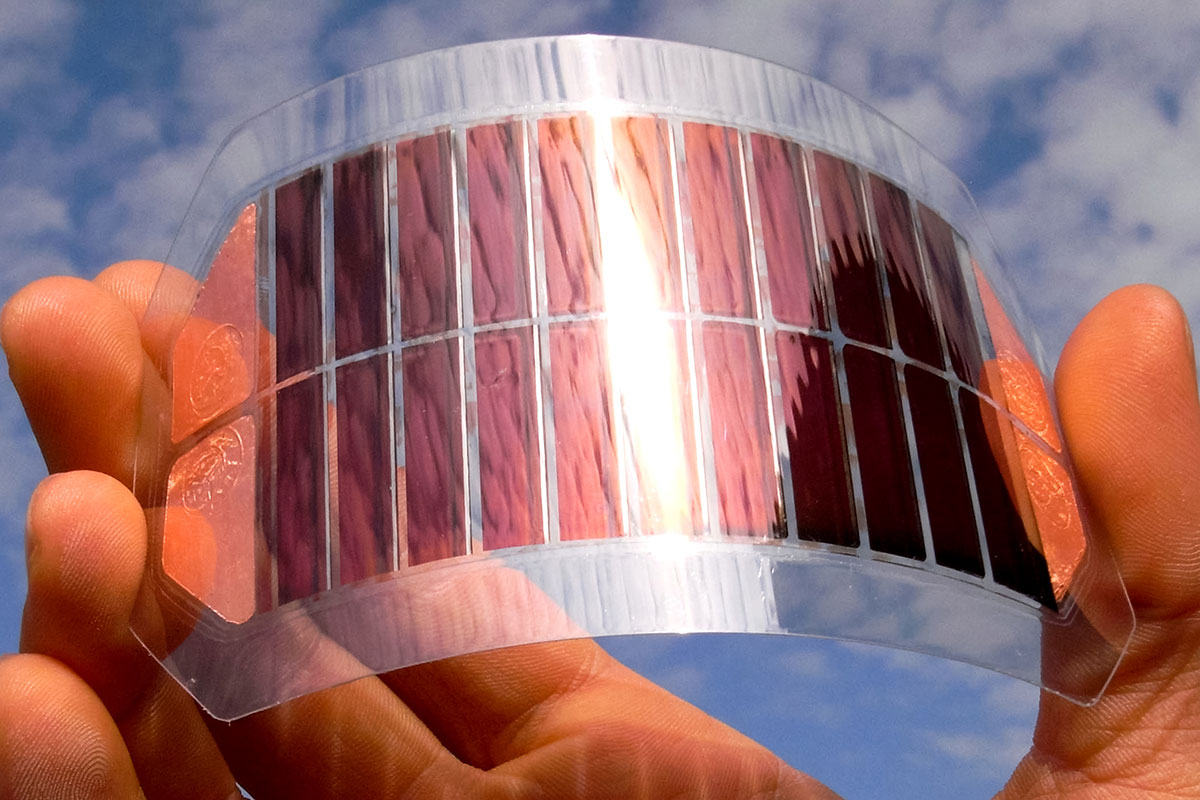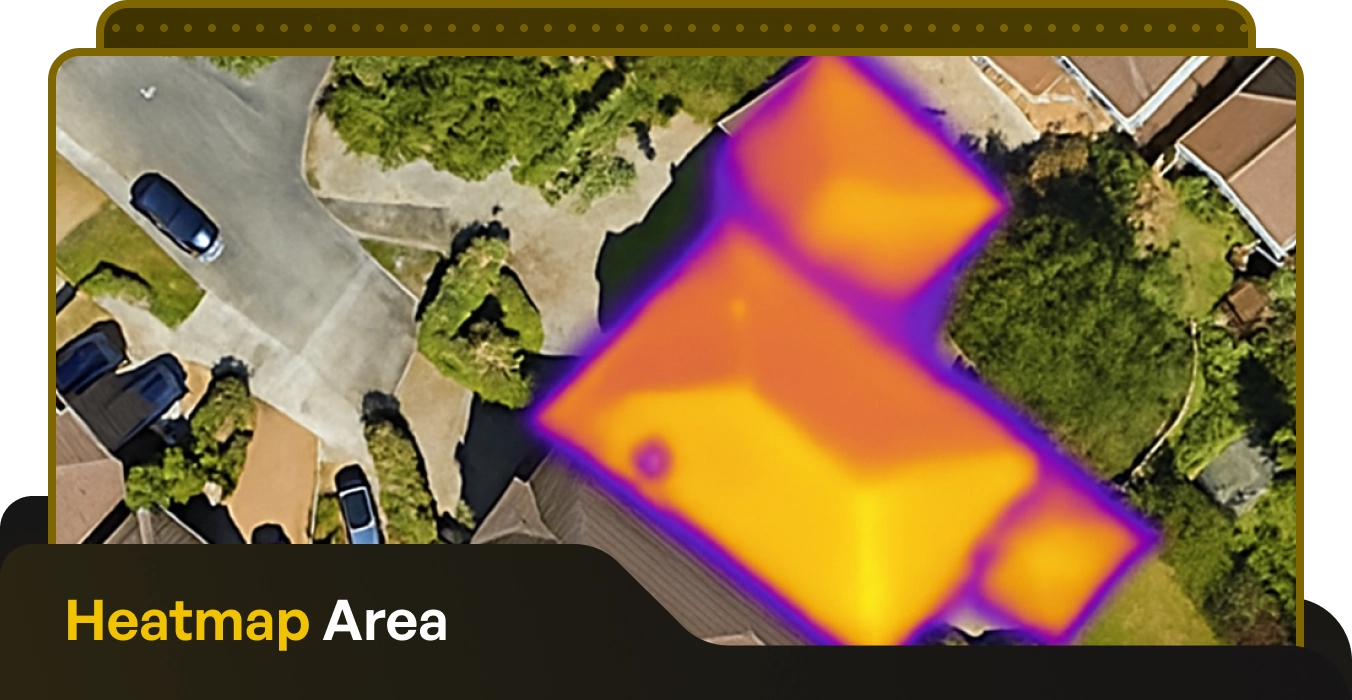Will Solar Energy Get More Efficient in the Future?

Written by: Briain Kelly
Published: August 14, 2023
Last updated: October 9, 2025
Reading time: 4 mins
There has been a rapid growth in solar panels in many countries across the world in recent years, including here in Ireland. Factors such as increasing electricity bills and global warming have contributed to the meteoric rise of solar PV panels in Ireland and globally.
While the many benefits of installing an array of solar panels are well documented, one of the drawbacks of solar power more generally is their relative lack of efficiency – i.e. the majority of solar energy that is not captured by solar cells and therefore not transformed into electricity.
But like all forms of technology, solar PV panels are constantly evolving, and the future looks bright, with technological advances which allow solar a higher percentage of the sun’s limitless energy along with rapidly falling costs.
What is solar efficiency?
Solar efficiency refers to the amount of energy from the sun which can be converted into electricity by solar cells.
Solar panels have solar PV cells, which contain semiconductor materials like silicon. Most domestic solar panels have one p–n junction – the boundary between two types of semiconductor materials, and the building blocks of solar cells.
When the PV cells are met with sunlight, an electrical current is created which is ultimately transformed into AC electricity by a solar inverter.
But the electricity that is produced is typically much less than the overall energy emitted by the sun’s rays.
Solar Panels Efficiency in the Past
Over 4% of the world’s electricity now comes from solar power, but until recently, progress had been slow. The first commercial solar panels were created in the 1880s – but the technology was extremely inefficient – at less than 1%.
It wasn’t until about 60 years later that the solar cell design, used in modern solar panels, was patented.
Solar PV panels saw an increase in efficiency and energy output over the decades since, and the early to mid 2000s brought a solar boom which has continued to this day.
The solar revolution meant that manufacturers had to come up with creative solutions to the problems of shade and orientation such as reintroducing micro-inverters, which increased efficiency.
Solar Panel Efficiency in 2023
While solar panels are far from harnessing all the sun’s energy, they have become much more efficient, with many panels installed on people’s roofs having efficiency
Nowadays, there are different types of PV panels which differ in their efficiency. More expensive mono-crystalline solar panels have an efficiency of up to 23%, while at the lower end of the scale, polycrystalline panels typically have an efficiency of up to about 17%.
Thin-film solar panels are usually even cheaper, but their lower cost and flexibility comes at a cost, as they typically have an efficiency of around 6% to 15%.
Could we capture more solar energy?
A typical domestic solar PV system has just one p–n junction and its energy output is therefore limited. However, modern advances in solar technology have shown promising signs for the future, with multi-junction cells being used to increase energy efficiency.
PV photovoltaic technology known as concentration PV (CPV) can produce more electricity than standard PV systems by using curved mirrors to direct sunlight onto multi-junction solar cells.
These CPV systems can use solar trackers or cooling systems to further increase their efficiency.
But with the highest solar efficiency of all existing solar PV technologies, high-concentration photovoltaics (HCPV) come close to 40% efficiency for production modules.

Record Solar Efficiency Rates
The world record for solar cell efficiency is a whopping 47.1%. The record was set in 2019 by the National Renewable Energy Laboratory (NREL) in the United States.
The renewable energy experts at the NREL used multi-junciton CPV solar cells under concentrated light in laboratory conditions.
The NREL also holds the record for solar cell efficiency in real-world conditions (39.5%) with triple junction cells.
Perovskite developments
Finding a better material for the solar panels is one way by which solar efficiency could be improved.
Traditional silicon solar panels could be replaced by perovskites — a mineral composed of titanium, oxygen and calcium. This could result in a huge improvement in solar efficiency as perovskite panels require less material and can be created in thin layers.
After more than ten years of R&D on perovskite panels, their efficiency rose from 2% to 25%, which is better than the most efficient silicon panels on the market today.
But while you might say, “well, problem solved then”, as with everything in life, things are rarely that simple.
A major benefit of solar PV panels is that they have lifespans of upwards of 25 years before seeing a drop-off in their efficiency.
The main stumbling block for perovskites is durability, and they tend to have a much shorter lifespan than their silicon based cousins.
They tend to be fragile, which is not something that will have to be addressed if they are ever to replace solar panels with silicon.
But research is ongoing, and tests are being constantly carried out on how to improve the durability of perovskite. Recent tests have found that adding organometallic compounds could increase their durability and efficiency.
We’ll have to wait and see, but for now, they are closing in on silicon and with a few tweaks, they could be the norm in the not-so-distant future.

Printing Solar Panels in the Future
One of the more ‘out-there’ possibilities for solar energy and their future is organic power cells, which are made by printing out PV material onto plastic sheets.
The producers of this technology are pushing ahead with the release of organic power cells, hoping that people are drawn to the paper-thin solar cells composed entirely of organic materials.
They are over 100 times lighter than silicon based cells and extremely quick to manufacture with printing technology. They even cost half as much to make as silicon-based cells.
Another benefit of the new organic cells on the block is their conversion efficiency rate not dropping when used indoors.
This makes them suitable for devices like smart speakers and sensors which not get to see a lot of actual direct sunlight, making use of existing ambient light, converting some of it to electrical power.
But as with perovskites, there’s one major drawback. This time it is their efficiency rate, which is as low as 10%, but they currently have a lifespan which is not far off that of silicon cell panels.

Get a Quote
Take the Energy Efficiency free online assessment to get the best quote for your homes solar panels.
Get in touch today to save on your home’s energy bills.
Will Solar Energy Get More Efficient in the Future?
Published: August 14, 2023
Last updated: October 9, 2025

Written by: Briain Kelly
Reading time: 4mins
There has been a rapid growth in solar panels in many countries across the world in recent years, including here in Ireland. Factors such as increasing electricity bills and global warming have contributed to the meteoric rise of solar PV panels in Ireland and globally.
While the many benefits of installing an array of solar panels are well documented, one of the drawbacks of solar power more generally is their relative lack of efficiency – i.e. the majority of solar energy that is not captured by solar cells and therefore not transformed into electricity.
But like all forms of technology, solar PV panels are constantly evolving, and the future looks bright, with technological advances which allow solar a higher percentage of the sun’s limitless energy along with rapidly falling costs.
What is solar efficiency?
Solar efficiency refers to the amount of energy from the sun which can be converted into electricity by solar cells.
Solar panels have solar PV cells, which contain semiconductor materials like silicon. Most domestic solar panels have one p–n junction – the boundary between two types of semiconductor materials, and the building blocks of solar cells.
When the PV cells are met with sunlight, an electrical current is created which is ultimately transformed into AC electricity by a solar inverter.
But the electricity that is produced is typically much less than the overall energy emitted by the sun’s rays.
Solar Panels Efficiency in the Past
Over 4% of the world’s electricity now comes from solar power, but until recently, progress had been slow. The first commercial solar panels were created in the 1880s – but the technology was extremely inefficient – at less than 1%.
It wasn’t until about 60 years later that the solar cell design, used in modern solar panels, was patented.
Solar PV panels saw an increase in efficiency and energy output over the decades since, and the early to mid 2000s brought a solar boom which has continued to this day.
The solar revolution meant that manufacturers had to come up with creative solutions to the problems of shade and orientation such as reintroducing micro-inverters, which increased efficiency.
Solar Panel Efficiency in 2023
While solar panels are far from harnessing all the sun’s energy, they have become much more efficient, with many panels installed on people’s roofs having efficiency
Nowadays, there are different types of PV panels which differ in their efficiency. More expensive mono-crystalline solar panels have an efficiency of up to 23%, while at the lower end of the scale, polycrystalline panels typically have an efficiency of up to about 17%.
Thin-film solar panels are usually even cheaper, but their lower cost and flexibility comes at a cost, as they typically have an efficiency of around 6% to 15%.
Could we capture more solar energy?
A typical domestic solar PV system has just one p–n junction and its energy output is therefore limited. However, modern advances in solar technology have shown promising signs for the future, with multi-junction cells being used to increase energy efficiency.
PV photovoltaic technology known as concentration PV (CPV) can produce more electricity than standard PV systems by using curved mirrors to direct sunlight onto multi-junction solar cells.
These CPV systems can use solar trackers or cooling systems to further increase their efficiency.
But with the highest solar efficiency of all existing solar PV technologies, high-concentration photovoltaics (HCPV) come close to 40% efficiency for production modules.

Record Solar Efficiency Rates
The world record for solar cell efficiency is a whopping 47.1%. The record was set in 2019 by the National Renewable Energy Laboratory (NREL) in the United States.
The renewable energy experts at the NREL used multi-junciton CPV solar cells under concentrated light in laboratory conditions.
The NREL also holds the record for solar cell efficiency in real-world conditions (39.5%) with triple junction cells.
Perovskite developments
Finding a better material for the solar panels is one way by which solar efficiency could be improved.
Traditional silicon solar panels could be replaced by perovskites — a mineral composed of titanium, oxygen and calcium. This could result in a huge improvement in solar efficiency as perovskite panels require less material and can be created in thin layers.
After more than ten years of R&D on perovskite panels, their efficiency rose from 2% to 25%, which is better than the most efficient silicon panels on the market today.
But while you might say, “well, problem solved then”, as with everything in life, things are rarely that simple.
A major benefit of solar PV panels is that they have lifespans of upwards of 25 years before seeing a drop-off in their efficiency.
The main stumbling block for perovskites is durability, and they tend to have a much shorter lifespan than their silicon based cousins.
They tend to be fragile, which is not something that will have to be addressed if they are ever to replace solar panels with silicon.
But research is ongoing, and tests are being constantly carried out on how to improve the durability of perovskite. Recent tests have found that adding organometallic compounds could increase their durability and efficiency.
We’ll have to wait and see, but for now, they are closing in on silicon and with a few tweaks, they could be the norm in the not-so-distant future.

Printing Solar Panels in the Future
One of the more ‘out-there’ possibilities for solar energy and their future is organic power cells, which are made by printing out PV material onto plastic sheets.
The producers of this technology are pushing ahead with the release of organic power cells, hoping that people are drawn to the paper-thin solar cells composed entirely of organic materials.
They are over 100 times lighter than silicon based cells and extremely quick to manufacture with printing technology. They even cost half as much to make as silicon-based cells.
Another benefit of the new organic cells on the block is their conversion efficiency rate not dropping when used indoors.
This makes them suitable for devices like smart speakers and sensors which not get to see a lot of actual direct sunlight, making use of existing ambient light, converting some of it to electrical power.
But as with perovskites, there’s one major drawback. This time it is their efficiency rate, which is as low as 10%, but they currently have a lifespan which is not far off that of silicon cell panels.

Get a Quote
Take the Energy Efficiency free online assessment to get the best quote for your homes solar panels.
Get in touch today to save on your home’s energy bills.
Solar Energy Saves Households Thousands in Electricity Costs
Take our 2-minute questionnaire and find affordable solar options to suit your budget and lifestyle.



